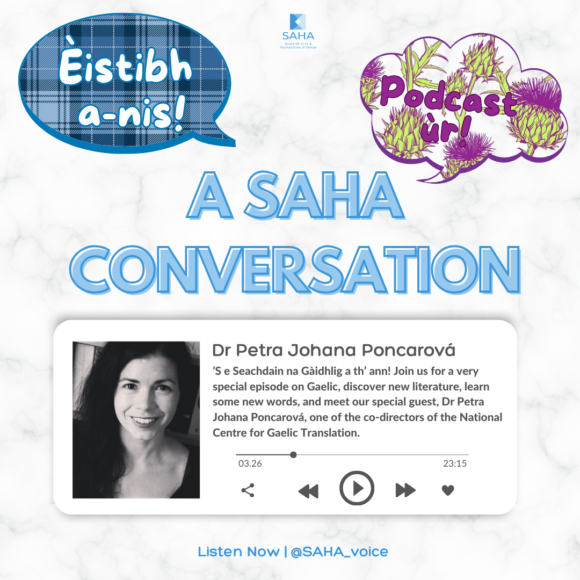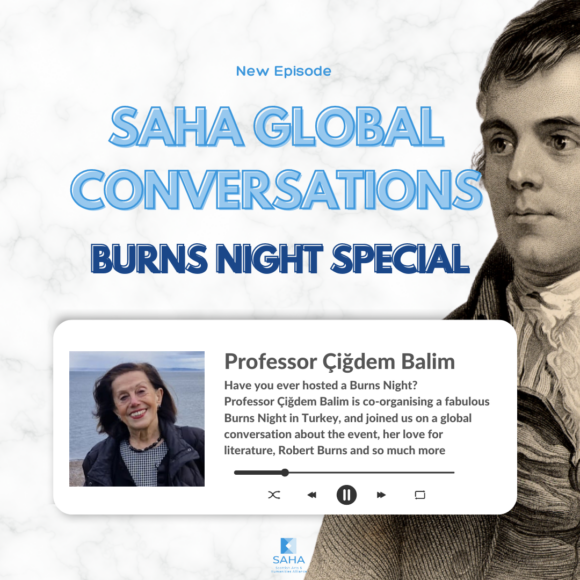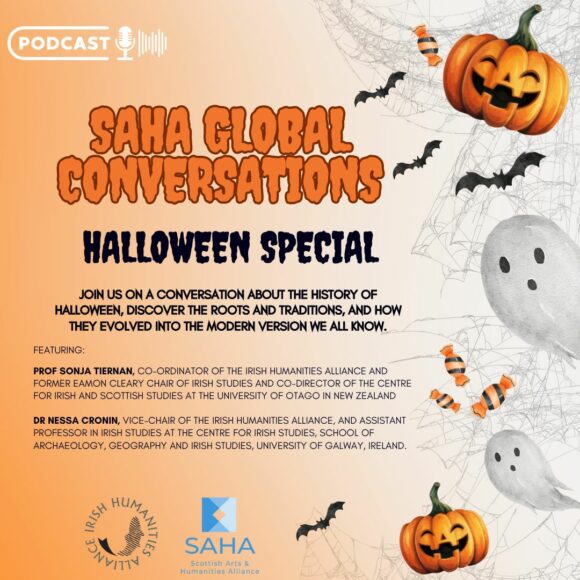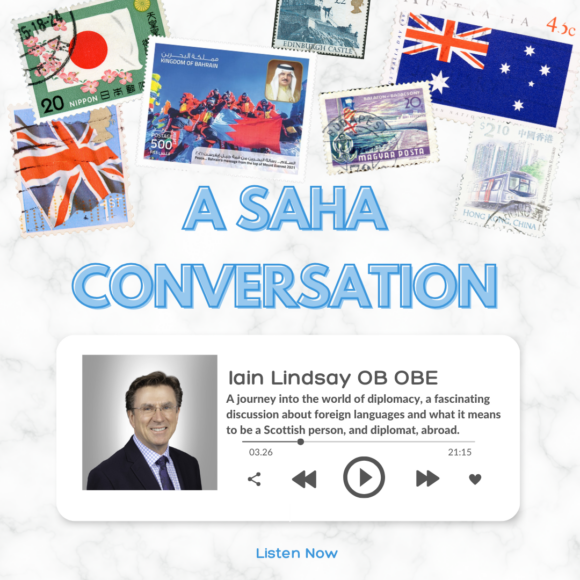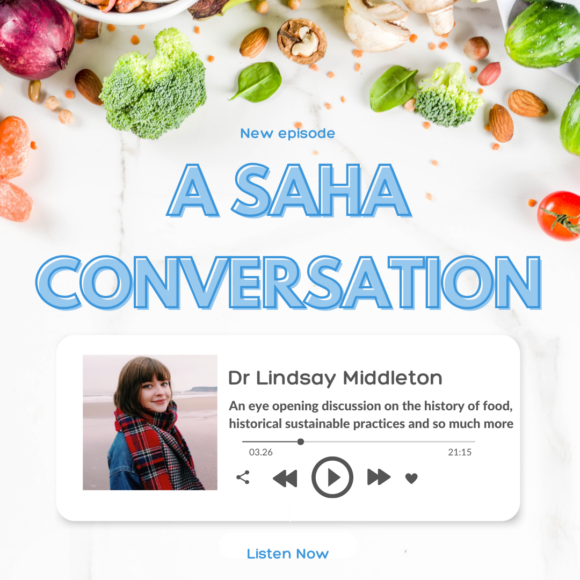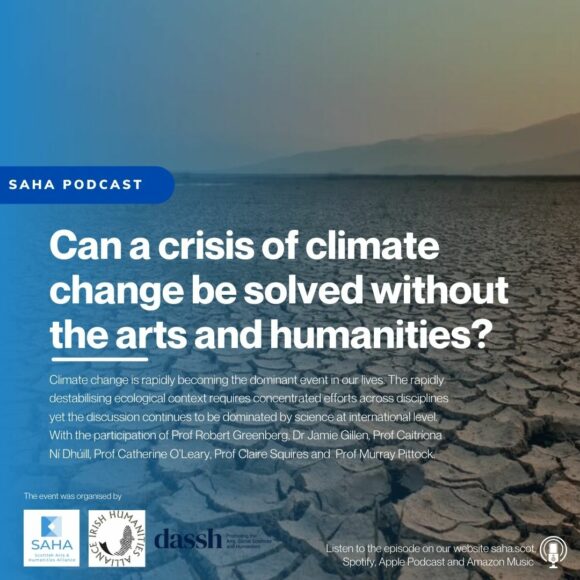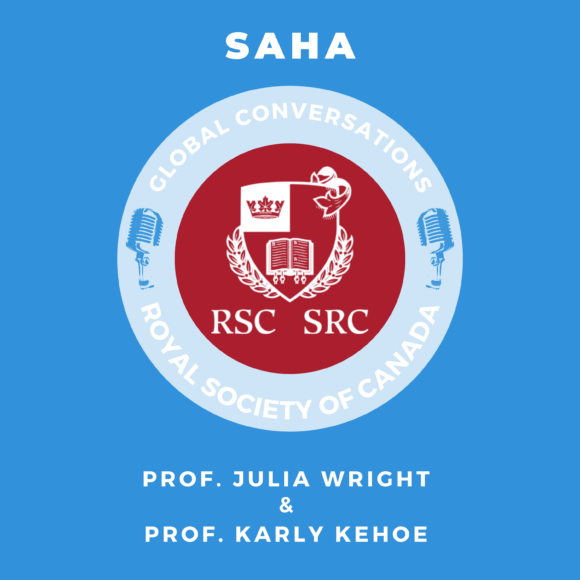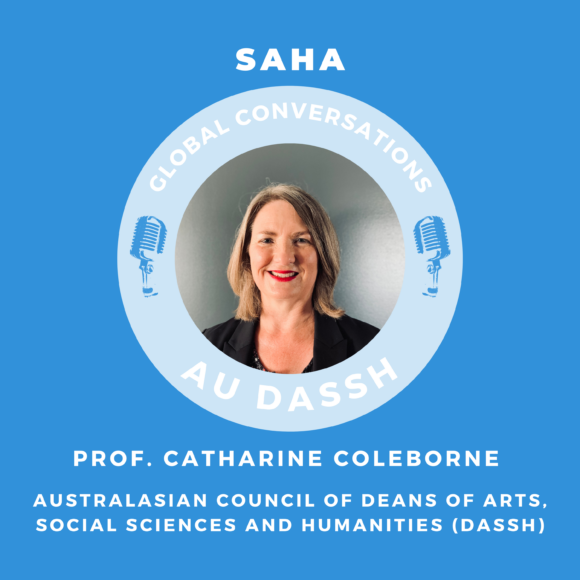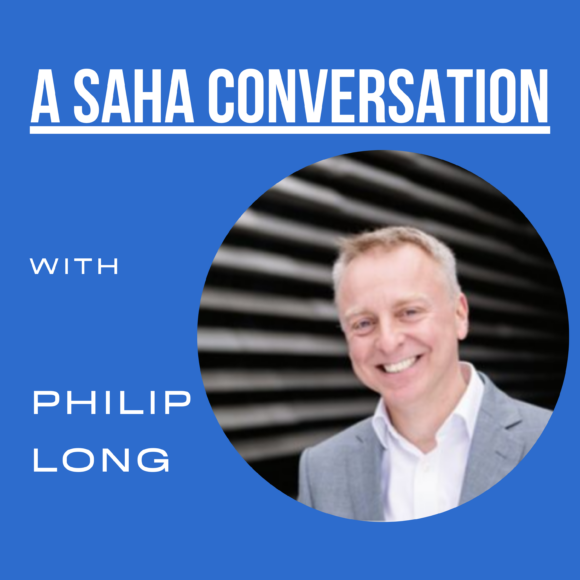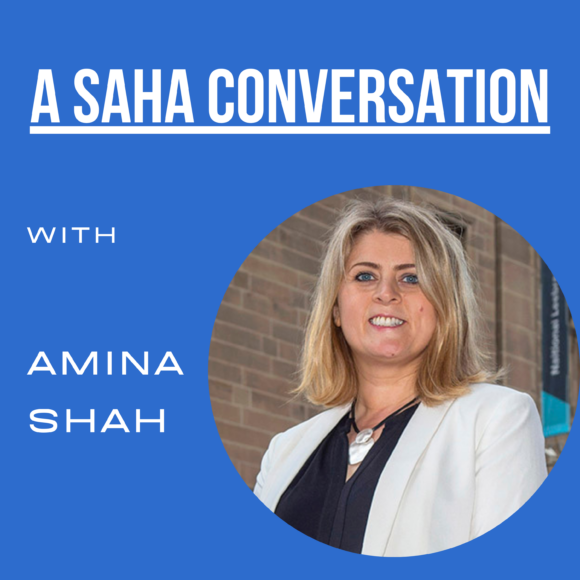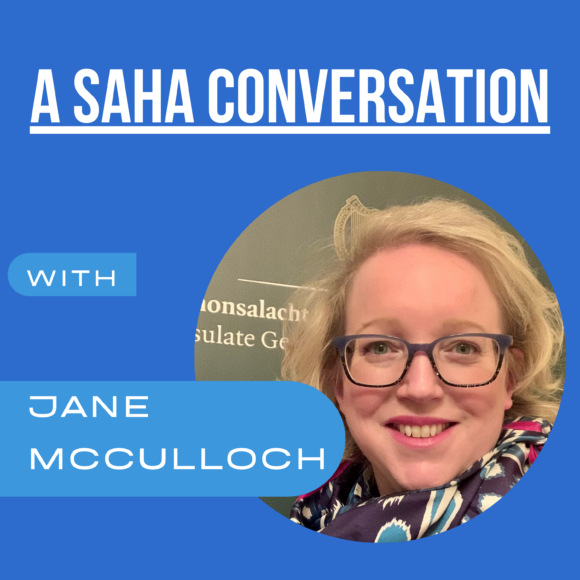Welcome to a new episode of A SAHA Conversation, a podcast by the Scottish Arts and Humanities Alliance.
In this episode, we will talk with Hazel de Vere, a conservator who has been working for the National Records of Scotland for almost three decades. She is part of the team that works really hard to preserve the Declaration of Arbroath, which is currently on display at the National Museum of Scotland.
In this SAHA conversation, Hazel will explain what it means to be a specialist in book and paper conservation, the important work behind preserving the Declaration of Arbroath, the unexpected wonders of the sector, and so much more.
You can listen to our podcast series on
If you liked this episode, please share it and leave a like on our Twitter, Facebook and Instagram profiles.
 Transcript
Transcript
Hello and welcome to a new episode of SAHA Conversations, a podcast by the Scottish Arts and Humanities Alliance, SAHA for short. SAHA brings together 15 higher education institutions, the Scottish Graduate School for Arts and Humanities and the Royal Society of Edinburgh to promote the contribution of arts and humanities to society. In this episode, we’ll talk with Hazel de Vere, a conservator who has been working for the National Records of Scotland for almost three decades. She is part of the team that works really hard to preserve the Declaration of Arbroath, which is currently on display at the National Museum of Scotland.
In this SAHA conversation, Hazel will explain what it means to be a specialist in book and paper conservation, the important work behind preserving the Declaration of Arbroath, the unexpected wonders of the sector, and so much more.
Thank you for joining us, Hazel. It’s an absolute pleasure to have you with us today. So, you’ve been a conservator for many years by now. How many so far, if we can say that?
I think we’re probably 29. I stopped counting.
Well, here at SAHA, we are very curious about academic stories and how they lead towards a certain career. So my first question is, or rather my first questions are how was your academic journey and what attracted you to this sector and how did you start and fall in love with your career?
I suppose I started getting interested in books when I was at school and I was studying the classics. And it was the days before Google and Amazon and ordering books online and to find text that I was interested in. I would go around antiquarian bookshops and secondhand bookshops. And then from there, I developed an interest in the structures and seeing different bindings. And so I actually chose, when I left school, to study paper conservation, which is unusual because a lot of people come to it later on in life because they haven’t yet discovered it. And so it’s what I chose to study. And I went on to do a certificate in archive conservation after I went to Camberwell and then I did Master’s in preventive conservation. And I can’t really imagine doing anything else. I’m not sure what I’d be able to do. But I enjoy it. And, yes, I fell in love with it very early on. That is wonderful. So it was a real love call from the beginning, love at first sight, if we can say that. Yes, it’s a wonderful mix of the arts, history, a bit of science and crafts, so it’s great. It encompasses them all.
So you’re a book and paper conservator, is that correct?
Yes, yes.
Can you explain that a little bit further? So, like any type of book, or just certain types of books and certain types of paper?
Well, most of my experience is, well working in Scotland, so I work with material that really is very British. We have some other structures, but we have very few, say, Islamic books, for instance. I’ve got a colleague who’s particularly interested in that area, so I’m very, more experienced with working with the structures that we have within an archival setting. Library books can be a little bit different, a little bit finer in their production, whereas account books often are a little bit more ad hoc in their production. So they can be very interesting, discover things. They don’t always follow the rules and the production of them. You can get many surprises in the sewing structures, for instance, when you’re going through them. Paper-wise, again, it’s very UK based, very Western based. We have very few Chinese or Japanese papers, for instance, although we use a lot of Japanese paper in conservation, so it’s very much in that area.
You say a lot “we”, could you please tell our audience where you work and where you’ve been for the last few years? Sorry. The Royal “we” National Records of Scotland, which formerly was the National Archives of Scotland, and then before that, when I started, it was a Scottish Record Office. So we’ve reinvented and merged over the time, and now we encompass birth deaths and marriages and census, as well as part of what we do.
That’s very cool. So every day there’s something different in your line of work?
Every day it could be something different. Although some projects can take a very long period of time and require a lot of patience, other things move quite quickly, so you don’t know what’s coming next. It could be something very, very interesting, something very bizarre, or something very mundane.
Well, every day is a different journey. So you mentioned something about the difference in stitching in the book covers and the way that books are put together. So, obviously, you’ve seen books from many different centuries so far. Can you tell us a little bit how the books themselves have changed and the paper has changed in the last maybe 100, 200 years?
I think one of the worst things was introducing trees into paper manufacture. The quality of paper went down significantly. It became very acidic with introduction of alum rosin. So as book production increased skills and the development of the book changed and they became less sound as a machine, if that makes sense. It became more about producing books quickly and so they didn’t function in quite the same way as they did early on. Paper has become very brittle and rather weak in comparison to early papers. So paper, after about 1850 is more challenging to work on than a paper from 14 and 15 1600. Not that we had much paper. We used a lot of parchment early on, but you could have the earliest piece of paper and it would be really easy to work with. Modern paper, not so much.
So the next generation might have an easier time with a much older piece of work than something more recent.
Yes. Modern materials present many different challenges from the pigments that they used to the introduction of plastics and different polymers. They present a lot of problems in archives that we are now having to deal with.
So if anyone in our audience is working on a book, please write this down. If you want your book to survive, use older material.
Just sound materials. Sound materials. It can be difficult in people creating artworks because they want the thing to look the way they want it to look, and sometimes they don’t mind it degrading, but sometimes that’s part of the project.
So that is a problem for a conservator. But not for the author. No, not for them. So it must be really fascinating, because every day you waltz through history from document to book to paper. So what is the oldest document you ever worked with?
I think the oldest document I ever worked with was actually when I was training and it was an 11th century document that was in a record office in England.
11th century?
Yes.
Wow.
The earliest document we have is 12th century, because many documents were removed during the wars of Independence and later by Oliver Cromwell and then sank on a ship. So a lot of Scottish early documents were removed. We only have up to starts about the 12th century.
Very interesting. Well, speaking of old documents, you are one of the people who look after the Declaration of Arbroath, is that right?
That is right, yes.
And the document is 700 years old, isn’t it?
Yes, over 700 years old. 703 now. We’re a bit late on the anniversary celebrations due to COVID, but we’re there now. We’re there now, yes.
Well, for those who don’t know, the Declaration of Arbroath is a letter from the community of the realm of Scotland, principally the barons, to the papacy and Pope John XXII, to argue for Scottish sovereignty and independence. And it is currently on display at the National Museum of Scotland in Edinburgh for the first time in 18 years. So this is quite the event that we’re having right now here. So how do you preserve such important piece of history?
Well, before you can preserve something, you have to understand what it’s made of, how it’s constructed to understand the degradation or the agents of damage that are going to affect it. We have to consider many things. How you’re going to use something, how it’s going to be handled, how it’s going to be displayed. All of these things need to be taken into consideration before you can actually approach any treatments, because they affect what you might do. It is a very fragile item, mainly due to its size and the nature of the materials that it’s made of. Being sheepskin, sheepskin has a tendency to delaminate. It suffered some damage in the past and so it’s undergone repairs a long time ago and those all present different issues for us now. The seals are fragile just because wax can easily break and chip. And the tags are very, very thin, so they’re almost like paper thin. So even though they’re made of skin, animal skin, they’re incredibly thin, so they’re prone to tearing, so any movement causes problems in the document. So we have to consider all of those things before we approach it and work on it.
Well, it is also 700 years old, so it is not a surprise that it’s quite fragile. So I went to see it the other day at the museum and it’s absolutely fascinating. And I do recommend this to anyone who can go here in Edinburgh. So what is the ink made of? How did they used to make ink back in the day?
It’s an iron gall ink, which was commonly used after you use carbon inks. We moved to Iron gall ink, and Iron gall ink was used up until about the start of the fountain pen, really. And it’s made from oak galls that they pick from trees, and they put iron salts in it and they then put there’s a solvent within it which would be like it could be water, wine, even urine, and a binder.
Wine?
Yes, wine.
Oh, wow.
I’d rather drink it. Oh, yes. And a binder. It has to have a binder in it, which was normally gum arabic, tree sap, and it was all mixed up together. And people would make their own ink, scribes would make their own ink. But it’s very, very acidic in nature, so it sort of bites into the skin of the parchment. But the way parchment is made, the document is made out of sheepskin parchment. Parchment is soaked and limed and then stretched and scraped and then sanded. And the introduction of the liming process to the skin makes the skin very alkaline. So you’ve got this very acidic material on a very alkaline material. And so the ink does bite into the skin. There is a chemical interaction there, but over time, due to the flexing of the skin and sometimes due to the breakdown of the binder, the ink can literally ping off the skin, which it doesn’t do on paper. Was this like a regular combination of paper and ink or was it a special one? No, it’s almost all the documents that we work on or that I work on the “Royal we” again are iron gall ink based.
That’s very fascinating. And when did that start changing?
With the introduction of the fountain pen you said? Yeah, they started introducing different materials because the iron content affected the nibs. You couldn’t use a metal nib with such a high iron content.
And what about the little seals at the bottom? Because when someone thinks of the Declaration of Arbroath, the first image you get is probably the document itself, and all the different colours at the bottom, there’s red, there’s green, as you said, they are very brittle. and they’re quite fragile, obviously, like everything else. How do you preserve them?
The seals on the Declaration I’ve done very little with because they’ve been repaired in the past. And although I could have improved the repairs, it would have meant a lot of flexing and turning of the document, which wouldn’t be worth doing, it wouldn’t be worth potentially risking the document further to improve the quality of the repairs. Generally, for repairing something, we try and keep it as similar, like with like as it would have been. And so when we repair seals, we use beeswax, and sometimes we might tone the wax down, sometimes we might not. We would introduce vermilion to get red or verdigris to get the green, we don’t as much put in resin. It would have had a resin content, but resin becomes quite brittle over time, so we tend not to put as much resin in our repair, so as some people do, but they’re quite enduring. The introduction of the pigment actually does help preserve them. Seals that have no pigment in them become very, very pale and delaminate into layers. So it’s quite interesting how a totally natural beeswax seal will degrade in a different way to one that has pigment within it. So the document is currently now at the museum here, the National Museum. It’s in a dark room, in a colder room. Is this the secret to preserve old documents, cold and dark? Well, we have to control it, because parchment, what’s very important for parchment, is also relative humidity. So we’ve got different agents of deterioration, we’ve got temperature, relative humidity, people, light and even pollution. So we try and remove as much of that as possible. The ink is quite faded and quite damaged and flaked. And with the delamination of the skin and also the previous damage, some of the ink and the Declaration is actually very fragile. So we’ve managed to reduce the lux levels to 20 in the case, and it’s actually quite bright, it’s quite legible, which is we’re really, really pleased with being able to get the lux down to that level to help preserve the document, because, as we all know, if you put something in light, it fades. When things become too dry, the skin will become very brittle. If things become too damp, you get mould and other damage and staining and you get pests or other problems can come in if your environmental conditions aren’t correct.
You mentioned pollution. Do you mean like environmental pollution? So, just the environment around us?
Yes, we have got many court records that have been very badly affected when all the chimneys were going in Edinburgh and they were covered in soot , covered in soot from where they’ve been kept. Frequently we’re removing black layers of soot from things.
Would it be because sometimes people just store their things in their attic, which I assume they’re quite damp and not the best place to preserve a document?
I think we’re in all sorts of places even now, people will keep records in the attic or in the basement. It’s the first place people put them because they don’t access them all the time and they’re generally the worst places, because if your roof leaks, the first thing that’s going to get it are your records. Generally, basements are damp. Not always, but frequently.
That’s a good tip. So remove all your documents from all the basements and your attics. To work on a document like that, you surely must ponder about the importance of history and the importance of preserving it, of course. So do you have a favourite story about a book or a document that you worked on that you can share with us?
I don’t know. There’s many things you’ve become very, very attached to over time and collections. That’s one of the advantages of having worked in the office for such long periods of time. So you get pet projects, if that makes sense, that you’ve worked on over and over again. And it’s quite difficult to pick one, Especially in such a long career. You must have seen it all. Well, but there’s things that keep coming back and back again, like the Madeleine Smith collection. It’s a famous story, a woman who got found not proven of murdering her lover in the Victorian period. And it comes back again and again and again because there’s all the fascination with did she, didn’t she? And we have all the objects from the trials, because we take in the court material up until about 1920, we also got all the evidence. So we have a whole collection of murder weapons and all sorts of things that you could possibly imagine that you’ll find in an archive, you do find in an archive. And so we have to try and manage that, manage people’s expectations, because people want to see the chocolate that was poisoned and they want to see the arsenic. And obviously we’ve got to consider that there are safety implications there. But there’s also fascinating, a series of wonderful, again, early parchment charters and the Pioneer charters that are covered in ecclesiastical fabric that have been taken from a church at some point and they’ve been cut up and they have little curtains attached by batons across the top because they were considered terribly important. And we’ve also got the earliest Scottish mediaeval chalice veil that was attached to Robert the Bruce document. And it’s a collection of Persian silks, wonderful Persian silks that, again, have been preserved because they were stitched to protect the documents. And so we’ve got some really fascinating collections that you wouldn’t expect to find. And I think archives have lots of stories still in there, not necessarily what you might be looking for, but that have been kept with them. We have a wonderful letter from 1849 describing a terrible potato blight that they were having in Shetland, and it’s a great description about what’s into the crops and what the plants looked like. And within the letter, they put seeds and potato tubers, diseased potato tubers. And so a while back, we actually saw it in the newspaper and thought, well, actually, we’ve got some of those, and we volunteered to take some samples. And so we took some samples and sent them away to the States. And lo and behold, they were able to prove with PCR testing on something from that age, that Shetland did indeed have the same pathogen that was affecting other parts of Scotland and Ireland, the potato blight. So, I mean, there’s still scientific information to be discovered. That is wonderful. Absolutely wonderful. People are looking there’s projects running just now where people are looking at animal skins, they’re looking at parchments. They’re doing analysis from eraser crumbs, and they can tell from the eraser crumbs, they can do species identification, so they can then say what species were used, which tells us how we lived, how we farmed. And there’s new techniques being discovered all the time. And so Conservators can help with scientists. We can work in tandem to get more information from these records that have been sitting there for hundreds of years. Not a single boring day for you at work must be Sometimes conservation can be a bit tedious if you’ve got a 500 page book and you’ve got to do the same thing 500 times and then the next treatment 500 times and then the next, sometimes it can be a little tedious as well.
Well, you must love it, because you’ve done it for quite some time.
Yes, I think I probably do.
Well, thank you very much for being with us today. I absolutely enjoyed this conversation. I hope our audience did the same.
Well, thank you for having me.
Thank you for joining us on this SAHA conversation. We hope you enjoyed it and learned something new. If you like this episode, please share it, subscribe and leave us a like on Twitter and Instagram @SAHA_voice on Facebook at Scottish Arts and Humanities Alliance.
